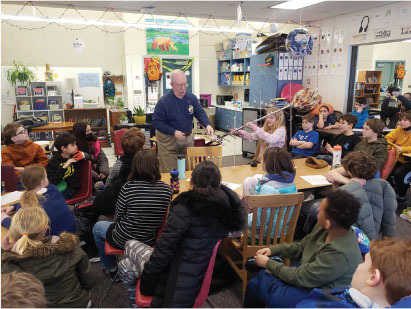May/June 2019
Variables
Tree House Escapes
Tree houses aren’t just for kids. Now, adults can also find a playful escape. And of course, PEs are putting their essential stamp on these opportunities for adventures in the sky.
NSPE member Charles Greenwood, P.E., has made a name for himself as one of the very few go-to professional engineers for private residential and recreational tree houses. The Oregon-based consultant has thousands of projects on his resume. Most of his current projects serve as Air BnB or retreat locales across the US and abroad.
Technology has improved to increase safety and resilience for these structures that are tied to a living, growing object. “We have been able to advance in the design process to successfully build for the long-term growth of the tree,” says Greenwood. “With the [older] design methods you could make a nice little tree house in the backyard for your kids, but you’d have to tear it down by the time they went to college because the tree had overgrown the design.”
The “Hideaway Woods” exhibit at the Museum of Life and Science in Durham, North Carolina is Greenwood’s favorite and most challenging project to date, because it involved state-of-the-art design to create a dynamic structure in a situation in which ensuring public safety was critical. The two-acre exhibit offers a nature discovery environment featuring a tree house village, a flowing streambed, and sculptures. “We created an exciting human experience on a structure that is essentially alive. That’s quite a different design experience than most engineers face.”
NSPE member Nabil Taha, P.E., entered into the tree house market in 2005 when a tree house designer needed licensed engineers for a project. “The layout or architectural drawing of a tree house is easy. As a licensed engineer, I ensure that the tree house is strong enough to safely support people,” says the principal engineer at Precision Structural Engineering Inc., in Klamath Falls, Oregon. The Out n’ About Treesort in Cave Junction, Oregon, offers an example of this unique tree house design work.
A Flexible Engineering Approach
Designing a tree house requires a flexible engineering approach. “You’re dealing with structures that must be by their nature flexible. A normal prescriptive path to design is actually dangerous with a tree house,” says Greenwood.
Testing has become a significant part of the process to ensure safety and long-term durability of tree houses. It all starts with assessing the health of the tree, which is done by a licensed arborist with a sensor test.
Load testing determines how much stress and weight a tree can handle. A tree attachment bolt (TAB) is installed and loaded hydraulically. Crushing is inevitable, so the test is limited to 0.030 inches of permanent deflection, which is measured after the load is released. Values for design load vary by fastener selection and by tree species—and even by individual trees, says Greenwood.
The load testing allows the design of the house to blend with the natural strength of the tree. Trees can grow their own version of rebar and concrete, says Greenwood, in response to the load. A design can induce productive growth in the tree and it will gain strength to adapt to the load of the construction materials and inhabitants.
How much does a tree house project cost? If you want one designed by someone with Greenwood’s and Taha’s expertise, you could pay nearly $50,000 up to $350,000 for a more sophisticated model.
Tree houses may have initially been created for little kids, says Taha, but what he loves most about them is that they are now also retreats for adults. “It’s just a beautiful feeling when you’re high up in the air and with the birds,” he says. “If you haven’t tried out one of these tree houses, you’re missing out. It’s interesting…it’s romantic…and can be an escape.”
 NSPE MEMBERS CHARLES GREENWOOD, P.E., AND NABIL TAHA, P.E., USE THEIR PROFESSIONAL ENGINEERING EXPERTISE FOR THE DESIGN, CONSTRUCTION, AND TESTING OF RESIDENTIAL AND RECREATIONAL TREE HOUSES. GREENWOOD WAS INVOLVED WITH THE “HIDEAWAY WOODS” TREE HOUSE PROJECT (TOP LEFT AND RIGHT) AT THE MUSEUM OF LIFE AND SCIENCE IN DURHAM, NORTH CAROLINA AND WITH THE DESIGN OF THE MARY PIGGOT TREE HOUSES (BOTTOM LEFT AND CENTER) IN SAMMAMISH, WASHINGTON. TAHA WAS INVOLVED WITH TREE HOUSE PROJECTS (BOTTOM RIGHT) AT THE OUT ‘N ABOUT TREESORT IN CAVE JUNCTION, OREGON.
NSPE MEMBERS CHARLES GREENWOOD, P.E., AND NABIL TAHA, P.E., USE THEIR PROFESSIONAL ENGINEERING EXPERTISE FOR THE DESIGN, CONSTRUCTION, AND TESTING OF RESIDENTIAL AND RECREATIONAL TREE HOUSES. GREENWOOD WAS INVOLVED WITH THE “HIDEAWAY WOODS” TREE HOUSE PROJECT (TOP LEFT AND RIGHT) AT THE MUSEUM OF LIFE AND SCIENCE IN DURHAM, NORTH CAROLINA AND WITH THE DESIGN OF THE MARY PIGGOT TREE HOUSES (BOTTOM LEFT AND CENTER) IN SAMMAMISH, WASHINGTON. TAHA WAS INVOLVED WITH TREE HOUSE PROJECTS (BOTTOM RIGHT) AT THE OUT ‘N ABOUT TREESORT IN CAVE JUNCTION, OREGON.


 Volunteering at NSPE is a great opportunity to grow your professional network and connect with other leaders in the field.
Volunteering at NSPE is a great opportunity to grow your professional network and connect with other leaders in the field. The National Society of Professional Engineers (NSPE) encourages you to explore the resources to cast your vote on election day:
The National Society of Professional Engineers (NSPE) encourages you to explore the resources to cast your vote on election day:
